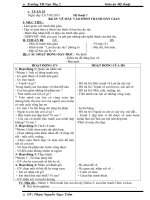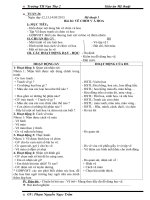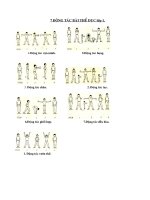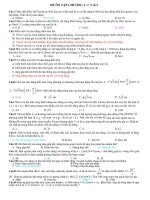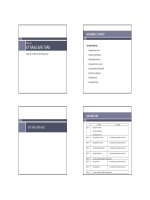NHÓM 5 bài dịch chương 1 2 3 sách power hydraulics
Bạn đang xem bản rút gọn của tài liệu. Xem và tải ngay bản đầy đủ của tài liệu tại đây (2.29 MB, 58 trang )
TRƯỜNG ĐẠI HỌC BÁCH KHOA TP.HCM
KHOA CƠ KHÍ
BÁO CÁO BÀI TẬP NHÓM
KĨ THUẬT
THỦY LỰC-KHÍ NÉN
Đề: Dịch các ví dụ chương 1, 2, 3 sách Power Hydraulics
THỰC HIỆN: NHÓM 5
HƯỚNG DẪN: TS. TÔN THIỆN PHƯƠNG
TP.HCM, THÁNG 10/2016
Kĩ thuật thủy lực khí nén
Hướng dẫn: TS. Tôn Thiện Phương
Danh sách thành viên và đánh giá
Tên
Nguyễn Tấn Lộc (Nhóm trưởng)
Lưu Khánh Quân
Trương Long Hưng
Võ Công Nguyên
Phạm Phùng Đăng Khoa
Nguyễn Văn Tấn
Thái Hoàng Long
Nguyễn Chí Hiếu
Ngô Đăng Minh
Nguyễn Văn Trung
Nguyễn Vĩnh Từ
Hoàng Minh Trường
Nhóm 5
Mã số sinh viên
21202014
1413137
1411639
1412579
1411848
1413477
1412105
1411185
1412273
1414308
1414574
1414334
Đánh giá
100%
100%
100%
100%
100%
100%
100%
100%
100%
100%
100%
100%
2
Kĩ thuật thủy lực khí nén
Hướng dẫn: TS. Tôn Thiện Phương
Mục lục
CHƯƠNG 1 : GIỚI THIỆU .................................................................................4
1. EXAMPLE 1.1 .............................................................................................4
2. EXAMPLE 1.2 .............................................................................................4
3. EXAMPLE 1.3 .............................................................................................5
CHƯƠNG 2 : CÁC LOẠI BƠM ..........................................................................7
1. EXAMPLE 2.1 .............................................................................................7
2. EXAMPLE 2.2 .............................................................................................8
3. EXAMPLE 2.3 .............................................................................................9
4. EXAMPLE 2.4 ...........................................................................................14
5. EXAMPLE 2.5 ...........................................................................................15
6. EXAMPLE 2.6 ...........................................................................................16
CHƯƠNG 3 : CÁC LOẠI VAN THỦY LỰC ...................................................43
1. EXAMPLE 3.1 ...........................................................................................43
2. EXAMPLE 3.2 ...........................................................................................43
3. EXAMPLE 3.3 ...........................................................................................43
4. EXAMPLE 3.5: RELATIVE EFFICIENCY OF ‘METER-IN’ AND
‘METER OUT’ FLOW CONTROL .........................................................................45
5. EXAMPLE 3.6 ...........................................................................................54
6. EXAMPLE 3.7 ...........................................................................................58
Nhóm 5
3
Kĩ thuật thủy lực khí nén
Hướng dẫn: TS. Tôn Thiện Phương
CHƯƠNG 1 : GIỚI THIỆU
1. EXAMPLE 1.1
The inlet to a hydraulic pump is 0,6 m below the top surface of the oil reservoir.
If the specific gravity of the oil used is 0,86 determine the static pressure at the pump
inlet.
Pressure = wh
Density of water is 1 g / cm3 or 1000 kg / m2
Therefore the density of oil is 0.86 1 g / cm3 or 860 kg / m3
Pressure at pump inlet 860 0.6 kg / m2
516 kg / m2
0.0516 kg / cm3
0.0516 0.981bar
2
Note 1kg / cm 0.981bar
VÍ DỤ 1.1
Ngỏ vào của một bơm thủy lực thì nằm ở độ sau 0,6 m so với bề mặt thoáng của
dầu. Nếu trọng lượng riêng của dầu sử dụng là 0,86, xác định áp suất tĩnh ở đường vào
của bơm
Áp suất = wh
Khối lượng riêng của nước là
hay
Vì vậy trọng lượng riêng của dầu là
hay
2. EXAMPLE 1.2
Calculate the pipe bores required for the suction of a pump delivering 40 l/min
using a maximum flow velocity in the suction line of 1.2 m/s and a maximum flow
velocity in pressure line of 3.5 m/s.
Consider the suction line
Let the bore of pipe be of diameter D
Therefore,
Nhóm 5
4
Kĩ thuật thủy lực khí nén
Hướng dẫn: TS. Tôn Thiện Phương
Minimum bore of suction pipe = 0.0266 m = 26.6 mm
Note: In all calculations great care must be taken to ensure that units are correct.
Alternatively, if a flow velocity of 1 m/s is used then suction pipe bore can be
shown to be of diameter 29 mm.
The required diameter of the pressure line can be calculate in a similar manner
taking the flow velocity is 3.5 m/s. Here, minimum bore of pressure pipe = 15.6 mm
It is unlikely a pipe having the exact bore will be available, in which case select
a standard pipe having a large bore. Alternatively a smaller bore pipe may be chosen
but it will be necessary to recheck the calculation to ensure that the flow velocity falls
within recommended range, i.e. a standard pipe with an outside diameter of 20 mm
and a wall thickness of 2.5 mm is available. This gives an internal diameter of 15 mm.
which is satisfactory.
It is also important to ensure that the wall thickness of the pipe is sufficient to
withstand the working pressure of the fluid.
VÍ DỤ 1.2
Tính đường kính ống hút và đường áp suất của bơm có lưu lượng 40 l/min và vận tốc
lớn nhất trong đường hút là 1,2 m/s, đường áp suất là 3,5 m/s.
Xét đường hút
Đường kính ống D
Vậy
3. EXAMPLE 1.3
A hydraulic pump delivers 12 liters of fluid per minute against a pressure of
200 bar.
1. Calculate the hydraulic power.
2. If the overall pump efficiency is 60%, what size electric motor would be need
to drive the pump?
Nhóm 5
5
Kĩ thuật thủy lực khí nén
Hướng dẫn: TS. Tôn Thiện Phương
A summary of formula of hydraulic power is given in section 6.2 of Chapter 6.
VÍ DỤ 1.3
Cung hệ thống thủy lực cung cấp lưu lượng 12l/phút chống lại áp suất 200 bar
1. Tính công suất thủy lực
2. Nếu hiệu suất tổng thể của bơm là 60%, kích thước của motor điện cần để
điều khiển bơm
Nhóm 5
6
Kĩ thuật thủy lực khí nén
Hướng dẫn: TS. Tôn Thiện Phương
CHƯƠNG 2 : CÁC LOẠI BƠM
1. EXAMPLE 2.1
A pump have a displacement of 14
is driven at
and
operates against a maximum pressure of 150 bar. The volumetric efficiency is 0.9 and
the overall efficiency is 0.8. Caculate:
i)
The pump delivery in liters per minute.
ii)
The input power required at the pump shaft in kilowatts.
iii)
The drive torque at pump shaft.
Pump delivery is:
If the flow Q is in liters per minute and the pressure P in bar then,
Torque at pump shaft,
VÍ DỤ 2.1
Một bơm có lưu lượng riêng 14 cm3/vòng với tốc độ 1440 vg/ph. Áp suất tối đa
150 bar. Hiệu suất thể tích 0,9; hiệu suất tổng 0,8. Tính
1. Lưu lượng của bơm
2. Công suất vào (kW)
3. Momen của bơm
Giải
Lưu lượng thực tế của bơm
Nhóm 5
7
Kĩ thuật thủy lực khí nén
Hướng dẫn: TS. Tôn Thiện Phương
Momen trên trục bơm:
2. EXAMPLE 2.2
A positive displacement pump with a delivery of 1 l/min is fed into a pipe with
a total volume of 1 liter. If the end of the pipe is suddenly blocked, calculate the rise in
pressure after 1 second.
( The bulk modulus of the fluid being pumped may be taken as 2000 MPa
(2000 bar); neglect any change in volume of the pipe.)
Note : Pascal (Pa) is another name for the unit of pressure N/ m2 . 1Mpa ( Mega
Pascal) =1,000,000 = 10 bar.
Bulk modulus is:
Volumetric stress
B=
Volumetric strain
P
B
V / V
Where P is the change in pressure, V is the change in volume , and V is
the original volume.
V Pump flow in one second=1/60liters
P=BV/V
1 / 60
=2000 x
( MPa)
1
33.3MPa 333bar
This rapid rise in pressure illustrate the necessity of having some form of
control to limit the rise in pressure in a system should a pump be deadheaded. The
control may be built into the pump or may be an external pressure-limiting devive such
as a relief valve.
VÍ DỤ 2.2
Một máy bơm chuyển tích cực với một lưu lượng 1 l / phút được đưa vào một
ống với tổng khối lượng của 1 lít. Nếu sự kết thúc của đường ống đột nhiên bị chặn,
tính toán việc tăng áp lực sau 1 giây.
(Các module biến đổi thể tích các chất lỏng được bơm có thể được thực hiện
như là 2000 MPa
(2000 bar); bỏ qua bất kỳ sự thay đổi về khối lượng của đường ống.)
Lưu ý Pascal (Pa) là một tên khác cho các đơn vị của áp lực. 1Mpa (Mega
Pascal) = 1.000.000 = 10 bar.
Module biến đổi thể tích là:
P
B
V / V
Nhóm 5
8
Kĩ thuật thủy lực khí nén
Hướng dẫn: TS. Tôn Thiện Phương
Với P là sự thay đổi về áp lực, V là sự thay đổi về khối lượng, và V là thể
tích ban đầu.
V Pump flow in one second=1/60 liters
P=BV/V
1 / 60
=2000 x
( MPa)
1
33.3MPa 333bar
Sự gia tăng nhanh chóng này áp lực minh họa sự cần thiết của việc có một số
hình thức kiểm soát để hạn chế sự gia tăng áp lực trong một hệ thống máy bơm. Việc
kiểm soát có thể được xây dựng vào trong máy bơm hoặc có thể là một thiết bị áp lực
giới hạn bên ngoài như một van xả.
3. EXAMPLE 2.3
A cylinder has to operate with the following time cycle: extend in 5 seconds at
25 bar, flow rate 12 l/min; remain extended for 25 seconds at 200 bar , no flow; retract
in 4 aeconds at 35 bar, flow rate 12 l/min; remain retracted for 26 seconds at 200 bar,
no flow.
Pressure/flow requirements are shown graphically in Figure 2.21. Flow is
requirement for only 15% of the cycle. With a single fixed-displacement pump circuit
(Figure 2.22) the pump output of 12 liters/min will discharge over the relief valve at
200 bar for 85% of the cycle time.
Theoretical input power is
Flow x Pressure=
12
x10-3 x200x105 =4000Nm/s=4kW
60
A major portion of which will be wasted as heat energy across the relief valve.
Considering the flow requirement curve in Figure 2.21 the flow needed during a
one-minute cycle is;
To extend the cylinder =12 x 5/60
To retract the cylinder =12 x 4/60
Total oil required per minute
Nhóm 5
9
Kĩ thuật thủy lực khí nén
Hướng dẫn: TS. Tôn Thiện Phương
Thus by storing the flow from the pump in an accumulator when the cylinder is
at rest (see Figure 2.20) a pump with a delivery rate of 1.8liters/min will be sufficient.
However since a minimum pressure of 200 bar is required during the cylinder rest
period, it will be necessary to operate above this pressure, to say 250 bar , and the
variation in circuit pressure (see Figure 2.23) may be disadvantageous. The pump
output is continuously charing the accumulator up to be included to limit the discharge
rate.
It is difficult to make the average pump supply exactly match the time average
circuit demand so a larger pump would be chosen with the excess flow discharging
over the relief valve.
If pump output greatly exceeds circuit demand so that the accumulator remains
at maximum pressure for a large proportion of the operating cycle, a pump unloading
system must be incorporated (preaaure relief/unloader valves are described in
Section3.1 of Chapter 3).
Theoretical power requirements assuming a pump delivery of 12 l/min with
excess fllow discharging over the relief valve at 250 bar is:
2 x10-3
x 250 x105 x10-3 = 0.83kW
60
Detailed examples of accumulator calculations are included in Section 6.4 and
6.6 of Chapter 6.
Nhóm 5
10
Kĩ thuật thủy lực khí nén
Hướng dẫn: TS. Tôn Thiện Phương
VÍ DỤ 2.3
Một xi lanh có để hoạt động với chu kỳ thời gian sau: duỗi ra trong 5 giây ở 25
bar, tốc độ dòng chảy 12 l / phút; duy trì việc duỗi trong 25 giây ở 200 bar, không có
dòng chảy; co lại trong 4 giây ở 35 bar, tốc độ dòng chảy 12 l / phút; duy trì việc rút lại
cho 26 giây ở 200 bar, không có dòng chảy.
Yêu cầu áp suất / lưu lượng được hiển thị đồ họa trong hình 2.21. Dòng chảy là
yêu cầu đối với chỉ 15% của chu kỳ. Với một mạch đơn cố định thuyên bơm (Hình
2.22) đầu ra bơm 12 lít / phút sẽ xả qua van xả ở 200 bar cho 85% thời gian chu kỳ.
Đầu vào công suất lý thuyết là:
Một phần lớn trong số đó sẽ bị lãng phí như năng lượng nhiệt qua van an toàn.
Xét đường cong yêu cầu dòng chảy trong hình 2.21 dòng chảy cần thiết trong
một chu kỳ một phút là;
Để duỗi trụ ra = 12 x 5/60
Để co xi lanh = 12 x 4/60
Tổng số yêu cầu mỗi phút dầu
Nhóm 5
11
Kĩ thuật thủy lực khí nén
Hướng dẫn: TS. Tôn Thiện Phương
Như vậy bằng cách lưu trữ các lưu lượng từ các máy bơm trong một phần còn
lại (xem hình 2.20) một máy bơm với tốc độ phân phối 1.8l / phút là đủ. Tuy nhiên, vì
một áp lực tối thiểu là 200 bar là cần thiết trong giai đoạn trụ còn lại, nó sẽ là cần thiết
để hoạt động trên áp lực này, để nói 250 bar, và các biến thể trong áp lực mạch (xem
Hình 2.23) có thể là bất lợi. Các bơm ra liên tục xả để hạn chế tỷ lệ xả.
Đó là khó khăn để làm cho việc cung cấp máy bơm trung bình chính xác phù
hợp với thời gian nhu cầu mạch trung bình để một máy bơm lớn hơn sẽ được chọn với
dòng chảy dư thừa xả qua van xả.
Nếu bơm ra rất vượt quá nhu cầu mạch để accumulator vẫn ở áp suất tối đa cho
một tỷ lệ lớn trong chu kỳ kinh doanh, một hệ thống dỡ bơm phải được hợp nhất ( van
giảm áp / van xả tải được mô tả trong Section 3.1 của chương 3).
Yêu cầu năng lượng lý thuyết giả định một giao bơm 12 lít / phút với dòng thừa
xả qua van xả ở 250 bar là:
2 x10-3
x 250 x105 x10-3 = 0.83kW
60
Ví dụ chi tiết về các tính toán cho ác quy có trong phần 6.4 và 6.6 của Chương
6.
Nhóm 5
12
Kĩ thuật thủy lực khí nén
Nhóm 5
Hướng dẫn: TS. Tôn Thiện Phương
13
Kĩ thuật thủy lực khí nén
Hướng dẫn: TS. Tôn Thiện Phương
4. EXAMPLE 2.4
Refer to Figure 2.24. A conveyor is driven by a hydraulic motor, and by using
three pumps of different volumetric displacement, seven stepped speeds are attainable,
in addition to zero
VÍ DỤ 2.4
Tham khảo Hình 2.24. Một băng tải được điều khiển bởi một động cơ thủy lực,
và bằng cách sử dụng ba máy bơm chuyển tích khác nhau, bảy bước tốc độ có thể đạt
được, ngoài không
Nhóm 5
14
Kĩ thuật thủy lực khí nén
Hướng dẫn: TS. Tôn Thiện Phương
5. EXAMPLE 2.5
A press requires a flow rate of 200 l/min for high-speed opening and closing of
the dies at a maximum pressure of 30 bar. The work stroke needs a maximum pressure
of 400 bar but a flow rate between 12 and 20 l/min will be acceptable.
Theoretical power required to open or close the dies is
(Nm/s) = 10000 Nm/s = 10 kW
To utilize power for the pressing process: if q is the available flow at 400 bar,
then
and q = 15 l/min
Which is acceptable.
Required pump deliveries are:
High- pressure, low- volume pump =15 l/min
High- volume, low- pressure pump = (200-15) = 185 l/min
An equivalent single fixed- displacement pump having a flow rate of 200 l/min
and working at a pressure of 400 bar requires a theoretical input power of 133,3 kW.
VÍ DỤ 2.5
Một máy ép yêu cầu tốc độ dòng chảy là 200 lít/ phút khi mở ở tốc độ cao và
đóng khuôn ở áp suất tối đa là 30 bar. Quá trình làm việc cần một áp suất tối đa là 400
bar ngoài ra thì tốc độ dòng chảy giữa 12 và 20 lít/ phút sẽ được chấp nhận được.
Công suất lí thuyết yêu cầu để mở hoặc đóng khuôn là:
Nhóm 5
15
Kĩ thuật thủy lực khí nén
Hướng dẫn: TS. Tôn Thiện Phương
(Nm/s) = 10000 Nm/s = 10 kW
Năng lượng sử dụng cho quá trình ép: nếu q là lưu lượng sẵn có tại 400 bar, sau
đó
and q = 15 lít / phút.
Vậy lưu lượng q chấp nhận được.
Lưu lượng bơm cần thiết là:
Áp suất cao, bơm đo thể tích thấp nhất là 15 lít / phút.
Thể tích cao, bơm áp suất thấp nhất là 185 lít/ phút.
Một bơm đơn chuyển cố định tương đương có tốc độ dòng chảy là 220 lít / phút
và làm việc ở áp suất 400 bar đòi hỏi một năng lượng đầu vào lí thuyết là là 133,3 kW.
6. EXAMPLE 2.6
Design data
The hydraulic system to be supplied by the pump has a circuit demand
characteristic for flow and pressure as shown in Figure 2.29. the complete cycle time is
30 second. The system demands fluid for only half its cycle time but requires to be
pressurized for two- thirds of the cycle. Flow controls may have to be used to set the
fluid rate to the valves requires. The fluid to be used is mineral oil, and there are no
other special requirements. Four alternative design will be considered:
Using a single fixed- displacement pump
Using two fixed- displacement pump
Using an accumulator system
Using a pressure- compensated pump
Nhóm 5
16
Kĩ thuật thủy lực khí nén
Hướng dẫn: TS. Tôn Thiện Phương
Answer:
1. Using a single fixed- displacement pump
Consider, a single fixed- displacement pump circuit as shown in Figure 2.19
Theoretical pump delivery = 25 l/min (allow an additional 10% approximately)
Therefore, pump delivery required = 27.5 l/min
System pressure maximum = 150 bar. (Set relief valve at 10% above system
pressure.)
Therefore, relief valve setting =165 bar.
These flow rates and pressure are within the range available for gear pumps
(see Table 2.4 giving details of single Dowty gear units).
Assume direct drive from 1440 rev/min motor. Calculate the equivalent
pump delivery at 1500 rev/min. Therefore, required pump delivery at 1500 rev/min is
27 1500
kW 28.7 l/min
1440
From Table 2.4 the nearest standard gear pump are:
1 PL 060 with a nominal delivery of 28.1 l/min at 1500 rev/min (equivalent to
27.0 l/min at 1440 rev/min). Maximum working pressure = 250 bar. This pump is just
within the system specification.
1 PL 072 with a nominal delivery of 33,6 liters/min at 1500 rev/min (equivalent
to 33.2 liters/min at 1440 rev/min) Maximum working pressure =210 bar.
2 PL 090 with a nominal delivery of 41,5 l/min at 1500 rev/min (equivalent to
26,6 l/min at 960 rev/min). This is almost exactly the same as alternative (a) but will
be more expensive owing to using a larger pump and a 960- rev/min electric motor.
The only advantage would be if using a fire-resistant fluid, but in this case a mineral
oil is specified.
Hydraulic energy required by the system 10 seconds after start of cycle is
25 150
kW 6, 25kW
600
Hydraulic energy required by the system 30 seconds after start of cycle (i.e.at
end of cycle) is
20 100
kW 3,3kW
600
Theoretical hydraulic power supplied using actual pump delivery, pump (a) or
pump (c) is
27 165
kW 7, 4kW
600
The cross- hatched area in Figure 2.30 represents energy dissipated as heat
within the system. The total theoretical energy supplied to the system by the electric
motor is 7,4kW for
Table 2.4 Dowty Powerline series of gear pump/motors.
Pump
type
Mortor
type
Nhóm 5
Theoretical
Displacement
(
/rev)
Maximum
Continuous
Pressure
P1(bar)
Min.pump
(rev/min)
Max.pump
(rev/min)
Min.motor
(rev/min)
Max.motor
(rev/min)
Typical
pump
Delivery
at
1500
rev/min
(l/min)
17
Kĩ thuật thủy lực khí nén
0PL
003
0PL
004
0PL
006
0PL
008
0PL
011
0PL
013
0PL
015
0PL
019
0PL
025
1PL
020
1PL
028
1PL
036
1PL
044
1PL
052
1PL
060
1PL
072
1PL
090
2PL
050
2PL
070
2PL
090
2PL
105
2PL
120
2PL
146
2PL
158
3PL
150
3PL
180
3PL
210
3PL
250
3PL
0ML
011
0ML
013
0ML
015
0ML
019
0ML
025
1ML
020
1ML
028
1ML
036
1ML
044
1ML
052
1ML
060
1ML
072
1ML
090
2ML
050
2ML
070
2ML
090
2ML
105
2ML
120
2ML
146
2ML
158
Nhóm 5
Hướng dẫn: TS. Tôn Thiện Phương
1.22
1.63
2.18
2.87
3.81
4.46
5.14
6.26
8.08
280
280
280
280
280
280
280
280
225
500
500
500
500
500
500
500
500
500
4000
4000
4000
4000
4000
4000
4000
4000
4000
500
500
500
500
500
4000
4000
4000
4000
4000
1.50
1.95
2.91
3.95
5.32
6.27
7.27
8.95
11.73
7.02
9.46
11.89
14.33
16.76
19.20
22.84
28.12
250
250
250
250
250
250
210
175
500
500
500
500
500
500
500
500
3000
3000
3000
3000
3000
3000
3000
2500
500
500
500
500
500
500
500
500
3000
3000
3000
3000
3000
3000
3000
3000
10.13
13.72
17.32
20.95
24.50
28.10
33.60
41.50
16.66
22.71
28.77
33.23
37.85
45.50
49.35
250
250
250
250
250
210
210
500
500
500
500
500
500
500
2500
2500
2500
2500
2500
2500
2500
500
500
500
500
500
500
500
3000
3000
3000
3000
3000
3000
3000
24.36
33.45
42.45
49.10
55.91
67.32
73.05
47.08
56.20
65.26
77.19
92.08
101.77
116.85
250
250
250
210
175
160
140
500
500
500
500
500
500
500
2500
2500
2500
2500
2250
2250
2150
68.9
82.5
96.1
114.1
136.6
150.9
173.5
18
Kĩ thuật thủy lực khí nén
Hướng dẫn: TS. Tôn Thiện Phương
300
3PL
330
3PL
380
20 seconds in a 30 second cycle.The total energy usefully consumed in each cycle is
that used between 5 and 10 seconds and between 20 and 30 seconds. Therefore
Total theoretical energy supplied =7.4x20kW(joules x10^3) =140 kJ
Total energy usefully used =(6.25x5/2) + (3.3x10/2) kJ=32.12 kJ
The system overall efficiency based on energy usefully used in the system
divided by energy supplied is
32.12 100
21.7%
148
2.Using two fixed-displacement pumps
When using two fixed-displacement pumps (circuit as shown in Figure
2.31),both pumps are used together to give the higher flow,and one pump only to give
the lower flow. Thus the theoreical pump deliveris required are 20 l/min and 5
l/min.As before,allow and additional 10% on theoretical pump deliveries.This give 22
l/min and 5.5 l/min.
Tandem or double pumps are availble from some gear pump manufacturers but
use a limited range of units. Table 2.5 shown a selection of units which can be
obtained in any combination.
The system is time –based and therefore a control timercan be used to switch
the pumps on and off load.
Actual pump deliveries taken from data sheet Table 2.5 are 22.9 l/min and 5.7
l/min for the size 16 and size 4,respectively at 1440 revs/min and 175 bar; the
deliveries will be almost the same at 165 bar.(A reduction in system pressure improves
the pump delivery by reducing leakage.)
Nhóm 5
19
Kĩ thuật thủy lực khí nén
Hướng dẫn: TS. Tôn Thiện Phương
Table 2.5. Units for use as tandem (double) pumps. Any two of the pumps may
be combined as a double units.
Nhóm 5
20
Kĩ thuật thủy lực khí nén
Hướng dẫn: TS. Tôn Thiện Phương
With the filters in the position in Figure 2.31, there will be a constant flow through
each filter irrespective of whether the system is on or off load and the oil pumped will
be filtered. If a single filter is placed in the alternative position only the oil used by the
system will be filtered, and the filter element will be subjected to flow surges as
solenoids (a) and (b) (Figure 2.31) are energized. Flow to the circuit is controlled by
these solenoid valves a and b, actuated from a timer. (Solenoid valves are described in
Chapter 3). With neither solenoid energized, flow from both pumps is returned to tank
at low pressure and hence little waste of energy. When a solenoid is energized, the
route to tank is blocked and the appropriate pump feeds the circuit.
Figure 2.32(a) show the quantity of oil delivered by the pump circuit (as the
relative solenoids are energized or de-energized) and the oil demanded by the system,
both to a base of cycle time. The cross-hatched area denotes the excess pump delivery
which will flow over the relief valves. This assumes flow-control valves are used in
the circuit to regulate the actuator speeds.
Hydraulic energy supplied by the 22.9 l/min pump to the system at 165 bar is
given by:
Similarly the hydraulic energy supplied to the system by the 5.7 l/min pump at
the 165 bar is given by:
Nhóm 5
21
Kĩ thuật thủy lực khí nén
Hướng dẫn: TS. Tôn Thiện Phương
The chart Figure 2.32(b) shows an analysis of the energy used by the system
and the energy supplied by the pumps against cycle time. The cross-hatched area
represents energy converted to heat which has to be dissipated within the system. Total
hydraulic energy supplied to system is
As before, total energy used by system is 32.12 kJ. The system efficiency based
on energy used in the system divided by the energy supplied by the pump is
3. Using an accumulator system
In an accumulator system, the fluid delivered by the pump is stored under
pressure in the accumulator until demanded by the system. To calculate the size of
accumulator the following have to be known, determined or assumed:
Maximum flow required from accumulator.
Maximum operating pressure.
Minimum system operating pressure.
Accumulator precharge pressure.
To calculate the maximum flow from the accumulator find the time-average
flow from the pump and the flows into the system which are as shown on a flow
diagram in Figure 2.29.
Flow to system =
=
=
Cycle average flow rate is
Cycle average flow rate is
The flow of fluid into or out of the accumulator can be calculated by
multiplying the flow rate by the flow time.
(i) Between 0 and 5 seconds the flow rates are:
Pump delivery = 0.18 l/s
System demand = 0
Flow rate into accumulator is 0.18 l/s
Flow into accumulator between 0 and 5 seconds is 0.18 x 5 liters = 0.9
liter.
Nhóm 5
22
Kĩ thuật thủy lực khí nén
Hướng dẫn: TS. Tôn Thiện Phương
(ii)
Similarly between 10 and 20 seconds the pump output flows into the
accumulator:
Flow into accumulator between 10 and 20 seconds is 0.18 x 10 = 1.8
liters.
(iii) During period 5 to 10 seconds:
Pump delivery = 0.18 l/s
Circuit demand = 25 l/min = 0.417 l/s
Flow rate from accumulator = 0.417 – 0.18 = 0.237 l/s
Flow from accumulator between 5 and 10 seconds is 0.237 x 5 liters =
1.185 liters.
(iv) During period 20 to 30 seconds:
Pump delivery = 0.18 l/s
Circuit demand = 20 l/min = 0.333 l/s
Flow rate from accumulator = 0.333 – 0.18 = 0.153 l/s
Flow from accumulator between 20 and 30 seconds is 0.153 x 10 liters
= 1.53 liters.
The flow of oil to and from the accumulator is shown in Figure 2.33. The
volume of oil to be stored in the accumulator is the maximum amplitude of Figure
2.33, i.e. 1.53 + 0.285 = 1.815 liters.
The maximum working pressure of the system is the maximum safe working
pressure of the lowest rated component. In this case assume a gear pump has been
selected with a maximum continuous working pressure of 207 bar and an intermittent
rating above this value. The minimum system pressure is set by the design criteria, i.e.
150 bar. The gas precharge pressure for the accumulator is usually 90% of minimum
system pressure, i.e. 0.9 x 150 = 135 bar.
In order to calculate the actual size of the accumulator, the various conditions of
the gas charge in the accumulator will be considered. These are shown in Figure 2.34.
It should be noted that values of pressure and temperature must be in absolute units for
all gas calculations.
The precharge pressure,
.
The maximum system pressure,
.
The minimum system pressure,
.
The minimum volume of oil to be stored in the accumulator is
. Assume isothermal compression between condition (a) and (b),
the charging period of the accumulator, then
V1 P2
208 / 136 1.529
V2 P1
Nhóm 5
23
Kĩ thuật thủy lực khí nén
Hướng dẫn: TS. Tôn Thiện Phương
Figure 2.33 Flow of fluid to and from accumulator.
Figure 2.34 Gas charge in the accumulator. (a) Pre-charge with gas. (b) Fully
charged with fluid. (c) Fully discharged of usable fluid.
Assume isentropic discharge between conditions (b) and (c) then
is the adiabatic index which may be taken as 1.4.
PV
2 2 PV
3 3 where
V3
V2 P2 P3 208 /151
V3 V2 208 151
1
1.257
Thus
V3 V2 1.815
V1 1.529V2
V3 1.257V2
From equation (2.5) and (2.7),
0.257 V2 = 1.815
V2 = 7.062
From equation (2.6)
Nhóm 5
24
Kĩ thuật thủy lực khí nén
Hướng dẫn: TS. Tôn Thiện Phương
V1 = 1.529 x 7.062 = 10.8 liters
An accumulator with a minimum capacity of 10.8 liters precharged to 135 bars
is required with a maximum working pressure of 207 bars. From accumulator
manufactures’ datasheets there is a choice of a 10- or 20-liter nominal capacity unit. If
the 10-liter accumulator is used it will result in a slightly longer cycle time. This can
be compensated for by using a slightly larger delivery pump. If the 20-liter capacity
accumulator is used, the maximum working pressure can be reduced resulting in a
more efficient system.
The pump has to deliver 10.84 l/min at a maximum pressure of 207 bars. From
the pump datasheets (Table 2.4) an OPL 025 has delivery of 11.73 l/min at 1500
rev/min and a maximum working pressure of 225 bars. A IPL 028 has a nominal
delivery of 13.72 1/min at 1500 rev/min and a working pressure of 250 bars. Because
of the higher working pressure, select the IPL 028 which will deliver 13.17 l/min at
1440 rev/min. Redraw the system demand and accumulator diagram using a pump
delivery of 13.17 l/min, i.e. 0.219 l/s. (See the Figure 2.35)
Nhóm 5
25



